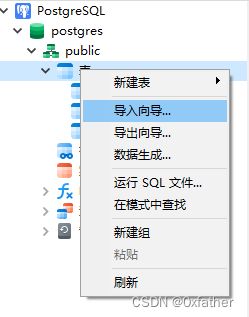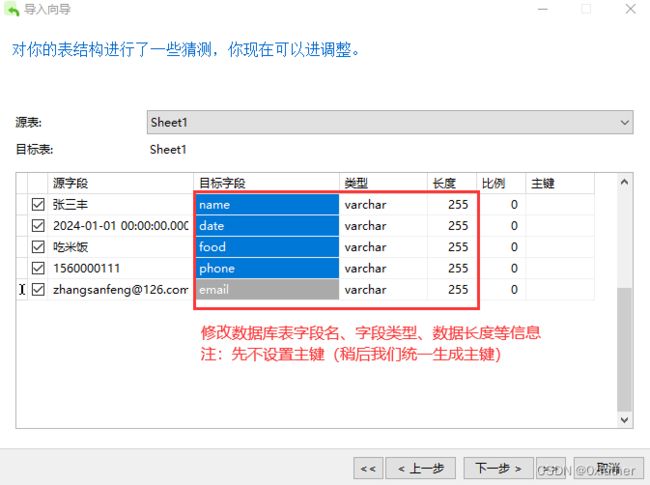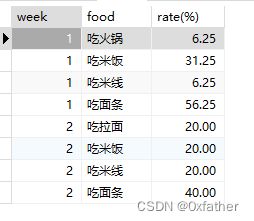Postgresql常见(花式)操作完全示例
案例说明
将Excel数据导入Postgresql,并实现常见统计(数据示例如下)
导入Excel数据到数据库
使用Navicat工具连接数据库,使用导入功能可直接导入,此处不做过多介绍,详细操作请看下图:
点击“下一步”完成导入操作(导入完成后,我们将表名命名为“eatLog”)。
给数据表添加自增主键
导入的数据是没有主键的,这样不利于我们对数据的管理(如:在查询时,没有数据主键不能对数据进行修改等),因此我们需要扩展主键字段
添加主键字段
修改表设计,增加主键id字段(此时请勿添加主键约束)
创建自增序列
Postgresql没有像Oracle、MySQL那样的默认自增序列,因此要实现自增,可以通过自定义序列来实现
create SEQUENCE seq_eatlog_id
start with 1
increment by 1
no MINVALUE
no MAXVALUE
cache 1;语句说明:
seq_eatlog_id:自定义的自增序列名称,根据自己需要命名
start with 1:序列从1开始
increment 1:序列自增步长为1(每次加1)
no MINVALUE:没有最小值约束
no MAXVALUE:没有最大值约束
cache 1:在数据库中始终缓存下一个序列
更新序列到数据表
update "eatLog"
set id = nextval('seq_eatlog_id')nextval函数可获取下一个序列,可使用 select nextval('seq_eatlog_id') 来查询下一个序列。
注:调用一次nextval(),序列将被消费掉,因此不要轻易使用nextval()来查询序列,避免序列顺序混乱。
此时id已填充为自增的序列值(此时可以再修改表设计,给该表增加主键非空约束,顺手把date字段的数据类型修改为日期类型,数据会自动转换)
给表主键增加自增序列
上面将主键已填充,但是在新增数据时,仍需手动添加主键,否则会提示主键为空问题。
insert into "eatLog" values('乔峰',to_date('2024-01-04','YYYY-MM-DD'),'吃拉面',null,'[email protected]');题外话:
Postgresql的表名和字段都是区分大小写的,因此针对驼峰名称必须添加双引号进行操作,否则会提示表或字段不存在
全大写或全小写的表名可以省略双引号
因此需要给主键id字段添加自增序列,以便后续新增数据。
alter table "eatLog" alter COLUMN id set DEFAULT nextval('seq_eatlog_id');
再次执行插入语句,即可添加成功(以后添加数据无需再管主键id字段了)。
常见日期操作
获取周
查询数据中的日期在当年第几周,并将周信息保存到数据库中,以便后续按周统计
表设计中增加“周(week)”字段
select date_part('week',date::timestamp) week from "eatLog";将周信息更新到表中
update "eatLog"
set week = date_part('week',date::timestamp)获取月
查询月份方式一(格式化字符方式):
select to_char(date,'MM') from "eatLog";查询月份方式二(日期函数获取):
select date_part('month',date::timestamp) from "eatLog";查询月份方式三(提取函数获取):
select extract(month from date) as month from "eatLog";查询部分时段数据
select * from "eatLog"
where date >= to_date('2024-01-05','YYYY-MM-DD')
AND date <= to_date('2024-01-08','YYYY-MM-DD')
and phone is not null数据脱敏
姓名脱敏
使用“*”号代替姓名中除第一个字和最后一个字的所有字符,两个字的名字仅替换最后一个字。
----三字及以上姓名脱敏
update "eatLog"
set name = concat(
left(name,1),
repeat('*', length(name) - 2),
right(name,1)
)
where length(name) > 2;
----两字姓名脱敏
update "eatLog"
set name = concat(
left(name,1),
repeat('*', length(name) - 1)
)
where length(name) = 2;concat()函数:用于拼接字符串
left()函数:用于截取字符串,指定从左截取多少位
right()函数:用于截取字符串,指定从右截取多少位
repeat()函数:用于替换字符串,指定替换多少位
手机号脱敏
保留手机号前三位和后四位,其他信息用“*”号代替
update "eatLog"
set phone = concat(
left(phone,3),
repeat('*',length(phone) - 7),
right(phone,4)
)
注:身份证、银行卡脱敏思路相同
邮箱脱敏
update "eatLog"
set email = concat(
left(email,1),
repeat('*',position('@' in email) - 2),
substring(email from position('@' in email))
)
substring()函数:截取字符串
position()函数:定位字符或字符串所在下标位置
数据统计
分组统计
根据周、饮食类型分组查询
select extract(week from t1.date) as week,t1.food,count(1)
from "eatLog" t1
group by extract(week from t1.date),t1.food
order by extract(week from t1.date)行转列统计
统计所有数据
select * from crosstab(
'select extract(week from t1.date) as week,t1.food,count(1)
from "eatLog" t1
group by extract(week from t1.date),t1.food
order by extract(week from t1.date),t1.food',
'select food from "eatLog"
group by food
order by food'
)
as (
week int,
吃火锅 NUMERIC,
吃拉面 NUMERIC,
吃馒头 NUMERIC,
吃米饭 NUMERIC,
吃米线 NUMERIC,
吃面条 NUMERIC
)
order by week行转列使用crosstab(sql1,sql2)函数
参数说明:
sql1:统计数据的语句
sql2:行转列的列查询SQL
crosstab的sql1返回值中必须有且只有三个字段:
第一个字段表示行ID(可由分组生成),
第二个字段表示分组目录(即待转换列),
第三个字段表示统计数据
as中的内容是转换的列名及列值类型,此处的列明必须完全列出,与实际数据相符,否则会报错误。
注一:
postgresql默认未安装扩展函数,因此要使用crosstab()函数,必须先启用扩展
使用命令:
CREATE EXTENSION IF NOT EXISTS tablefunc;
注二:
行转列时,sql2参数必须进行排序,若不排序,虽然能转成功,但是会发现数据可能已经混乱,postgresql在行转列时,通过as中指定顺序匹配,而非是通过字段名称匹配,所以orader by固定数据位置,很容易造成匹配错误(as中的顺序可以使用sql2执行之后确认是否一致)
统计部分数据
select * from crosstab(
'select extract(week from t1.date) as week,t1.food,count(1)
from "eatLog" t1
where t1.date >= to_date(''2024-01-05'',''YYYY-MM-DD'')
AND t1.date <= to_date(''2024-01-08'',''YYYY-MM-DD'')
group by extract(week from t1.date),t1.food
order by extract(week from t1.date),t1.food',
'select food from "eatLog"
group by food
order by food'
)
as (
week int,
吃火锅 NUMERIC,
吃拉面 NUMERIC,
吃馒头 NUMERIC,
吃米饭 NUMERIC,
吃米线 NUMERIC,
吃面条 NUMERIC
)
order by week在crosstab的sql参数中,若已经使用了单引号('),则需要使用两个单引号('')表示一个单引号,用于转义,否则SQL执行报错
另外,SQL查询时,若表名或字段使用驼峰时,必须使用双引号修饰,否则会找不到对象(Postgresql严格区分大小写,全大写或全小写时可以省略双引号修饰)
自定义统计列
select * from crosstab(
'select
extract(week from t1.date) as week,
t1.food,
count(1) food_count
from "eatLog" t1
where t1.date >= to_date(''2024-01-05'',''YYYY-MM-DD'')
AND t1.date <= to_date(''2024-01-08'',''YYYY-MM-DD'')
group by extract(week from t1.date),t1.food
order by extract(week from t1.date)',
$$values('吃火锅'),('吃米饭'),('吃米线'),('吃面条')$$
)
as (
week int,
吃火锅 NUMERIC,
吃米饭 NUMERIC,
吃米线 NUMERIC,
吃面条 NUMERIC
)
order by week可通过$$values()$$来指定转哪些列,注意values()的顺序必须与as中的顺序一致
其他操作
计算精度问题
试想,我们的数据是统计每周的饮食统计,那每种饮食在每周占比是多少呢?
select m1.week,m1.food,m1.food_count,
(
select
count(1) week_count
from "eatLog" t2
where t2.date >= to_date('2024-01-05','YYYY-MM-DD')
AND t2.date <= to_date('2024-01-08','YYYY-MM-DD')
and extract(week from t2.date) = m1.week
group by extract(week from t2.date)
order by extract(week from t2.date)
) week_count
from
(
select
extract(week from t1.date) as week,
t1.food,
count(1) food_count
from "eatLog" t1
where t1.date >= to_date('2024-01-05','YYYY-MM-DD')
AND t1.date <= to_date('2024-01-08','YYYY-MM-DD')
group by extract(week from t1.date),t1.food
order by extract(week from t1.date)
) m1
order by m1.week,m1.food计算占比时请注意精度问题
select m1.week,m1.food,round(m1.food_count::numeric /
(
select
count(1) week_count
from "eatLog" t2
where t2.date >= to_date('2024-01-05','YYYY-MM-DD')
AND t2.date <= to_date('2024-01-08','YYYY-MM-DD')
and extract(week from t2.date) = m1.week
group by extract(week from t2.date)
order by extract(week from t2.date)
)::numeric * 100,2) "rate(%)"
from
(
select
extract(week from t1.date) as week,
t1.food,
count(1) food_count
from "eatLog" t1
where t1.date >= to_date('2024-01-05','YYYY-MM-DD')
AND t1.date <= to_date('2024-01-08','YYYY-MM-DD')
group by extract(week from t1.date),t1.food
order by extract(week from t1.date)
) m1
order by m1.week,m1.foodPostgresql在计算时默认使用int来计算,因此不会取小数,若需要保留小数,需指明参加运算的字段类型,可通过“::numeric”来指明运算字段为数字型,这样运算结果可以保留小数
要具体精确到多少位,需要使用round()函数
行转列后效果
select * from crosstab(
'select m1.week,m1.food,round(m1.food_count::numeric /
(
select
count(1) week_count
from "eatLog" t2
where t2.date >= to_date(''2024-01-05'',''YYYY-MM-DD'')
AND t2.date <= to_date(''2024-01-08'',''YYYY-MM-DD'')
and extract(week from t2.date) = m1.week
group by extract(week from t2.date)
order by extract(week from t2.date)
)::numeric * 100,2) "rate(%)"
from
(
select
extract(week from t1.date) as week,
t1.food,
count(1) food_count
from "eatLog" t1
where t1.date >= to_date(''2024-01-05'',''YYYY-MM-DD'')
AND t1.date <= to_date(''2024-01-08'',''YYYY-MM-DD'')
group by extract(week from t1.date),t1.food
order by extract(week from t1.date)
) m1
order by m1.week,m1.food',
'select food from "eatLog"
group by food
order by food'
)
as (
week int,
吃火锅 NUMERIC,
吃拉面 NUMERIC,
吃馒头 NUMERIC,
吃米饭 NUMERIC,
吃米线 NUMERIC,
吃面条 NUMERIC
)
order by week以上,就是Postgresql在使用中常见操作及示例说明,希望对您有所帮助。



















